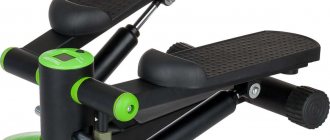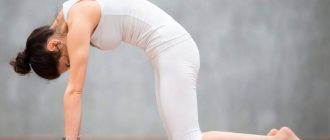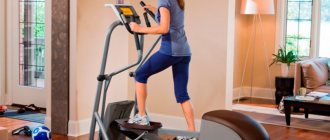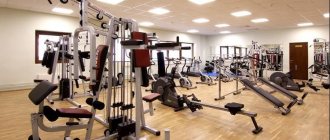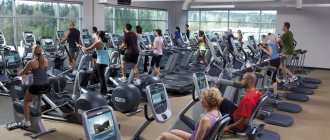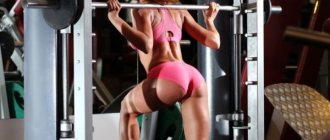Steppers are a class of cardio equipment that, despite their apparent simplicity, have great potential for sports. The basic elements of a classic stepper are two platform pedals on which stepping exercises are performed - simulating fast or slow walking with the desired level of load.
The modern market offers a variety of variations of this simulator: from simple floor-standing models with a mechanical drive, to full-length simulators with handles, an electric system for creating loads, display of training parameters, etc. Regardless of the level of technical advancement, the essence of all steppers remains the same. We will talk about it, answering the main questions related to these simulators.
What are the benefits of using a stepper?
Stepper
- This is a general strengthening cardio exercise machine. It is designed to perform stepping exercises that simulate walking on steps. Classes are aimed primarily at strengthening the gluteal muscles and leg muscles. The main loads fall on the quadriceps and calf muscles. In rotating models, which allow you to imitate skiing, the oblique abdominal muscles are additionally actively involved in the work. In steppers with handles or expanders, the loads extend to the arms and shoulder girdle.
Like all aerobic exercise machines, the stepper has a complex effect - it strengthens the knees and muscles, the cardiovascular and respiratory systems. Exercising on a stepper increases the overall tone of the body, promotes weight loss, and is a mandatory component of fitness programs. Training improves the functioning of the circulatory system, strengthens blood vessels, and relieves general fatigue. Exercises on this machine are recommended as a cardio warm-up before strength training and when recovering from injuries.
Benefits and contraindications of exercises
Working out on a home cardio machine is not only aerobic exercise for muscles and strengthening them.
Step exercises also allow:
- reduce weight;
- improve coordination of movements;
- activate the work of the heart, lungs, and brain;
- train the lungs and improve blood supply to the muscles of the limbs, abdominal cavity and pelvis;
- develop general body endurance;
- strengthen blood vessels and normalize blood pressure;
- increase the power and strength indicators of the body;
- reduce the amount of body fat.
6 more facts about the benefits of the stepper here
Scientists have proven: after three months of exercise, lung volume increases by 8.6%, waist circumference becomes smaller by 2%, and cholesterol levels decrease by 3.9%.
However, there are restrictions and contraindications for practicing on a stepper.
You should stop taking classes if you:
- injuries have not yet been completely cured (dislocations, fractures, sprains, etc.) or you suffer from serious diseases of the joints and spine;
- suffered a heart attack or stroke;
- have chronic diseases of internal organs - kidneys, liver, lungs (asthma);
- are in the last stages of pregnancy;
- suffer from arterial hypertension or diabetes mellitus in the acute stage;
- being treated for colds with high fever.
Important! People who are significantly overweight and older people who love a healthy lifestyle should consult a doctor before starting exercise.
How does a stepper benefit from regular walking?
Hydraulic pistons of even the simplest floor steppers provide a soft, elastic and uniform pedal stroke, so that during exercise the knee joints are not subject to shock loads, as during normal walking. This is especially important when it comes to injury rehabilitation and training for older people.
An undoubted advantage of the simulator is the ability to control the overall level of load. When exercising on a stepper in a calm home environment, it is much easier to monitor your breathing, which is the key to effective aerobic exercise, in which oxygen is a key source of energy.
With a stepper, you can perform step exercises of varying complexity, monitor cardio data displayed on the display, and simultaneously exercise with dumbbells or an expander - all this significantly increases the effectiveness of training compared to regular walking. And, of course, training on a simulator is very convenient: they do not require complex preparation, the weather will not make adjustments to your training regimen, and during training you can calmly listen to music or watch your favorite TV series.
Brief characteristics of various types of simulator
A stepper is a step-by-step cardio exercise platform that, using built-in pedals on levers, simulates climbing stairs. The legs work alternately on it. You can also use your arms, just like during normal walking.
This is a very natural motor activity for humans , however, adjusting the resistance of the pedals allows you to increase the load and apply effort to walking. This is the basic principle of this cardio.
A large number of modifications of steppers gives both beginners and physically trained athletes the opportunity to choose. Stepper designs may differ in the loading system (mechanical and electromagnetic), pedal stroke (interdependent or independent), size, design, set of functions and programs, and, depending on this, cost.
According to the type of movements performed and design features, steppers are divided into:
- Classic . The basic version of a stepper imitates the most common walking climb up the stairs. It can be equipped with various devices for stability and activation of the muscles of the upper body: racks, levers, expanders.
- Mini stepper. A smaller version for training in confined spaces and convenient transportation (for home use). The design is very suitable for beginners who cannot immediately switch to heavy loads (overloading the heart suddenly and without preparation can negatively affect its health).
- Rotary (with rotating handle) . Such models are equipped with a handle that turns from side to side, thanks to which the upper part of the body turns from side to side in unison with the steps. Such movements help to pump up the abs, back and waist along with the legs.
- With expanders. In this version, elastic cords with expanders are attached to the platform with pedals. With their help and correct use during training, in addition to the legs, the arms, back and shoulders are also worked out. We described how to use expanders correctly in this version in a separate article.
- Balancing (side) . This model is designed on the tumbler principle and resembles a small leg swing with an invisible horizontal axis in the middle. Steps on such a simulator are rolling from side to side while maintaining body balance in the center. The balance beam exercises the entire body, develops balance and coordination, and takes up very little space.
- Elliptical. The electromagnetic loading system allows you to increase the amplitude and smoothness of the step, and also, thanks to moving levers, to connect your arms. Almost the entire body is involved in the work, the steps resemble the rotation of the pedals of a huge bicycle, the work of the hands resembles the movements of a skier. This is the most gentle of the steppers in relation to the joints.
- Children's. The peculiarity of this option is that, while performing the same functions as a stepper for adults, it is designed specifically for children from 4 years old. Such simulators are bright, colorful, very durable and safe. They are designed to interest the child in playing sports and give a start to his physical development from an early age.
How do ministeppers differ from their full-length counterparts?
Steppers
– This is a fairly broad category of cardio equipment. They may differ in design, type of loading mechanism, and the possibility of additional rotary or balancing movements. For home workouts, they usually choose the simplest options - floor-mounted ministeppers or exercise machines with handles.
Ministeppers
– category of the simplest floor exercise equipment for home use. They are a compact platform with two pedals, their weight varies between 6-8 kg. The load in such models is created using two hydraulic cylinders, and can be either adjustable or unregulated. Many ministeppers are equipped with expanders for additional training of the muscles of the arms, shoulder girdle and back. Designed for users weighing 100-120 kg.
Mini steppers can have a stand with handles to provide additional stability during training.
Advantages:
• small dimensions, thanks to which the exercise machine is easy to put away, for example, under the bed;
• light weight; • independence from power supply; • the presence in almost all modern models of a simple computer displaying training time, number of steps, rhythm, calories burned; • the ability to select models with an expander; • affordable price. Disadvantages: • inability to control loads in most models; • the pedal stroke of ministeppers is often interdependent; • the computer displays only the simplest parameters, without cardiac data. Full-length home Nordic walking steppers are designed to train the muscles of the legs and upper body. They differ from ministeppers in size and the presence of two movable handrails.
In more advanced models, the handles serve not just as a fulcrum that helps maintain balance, but are an active power unit that gives additional stress to the arms and back. Most home models use mechanics based on hydraulic cylinders as a loading system. But among such steppers, there are more often options with the ability to adjust loads, separate pedal strokes and advanced cardio computers.
Main manufacturers
HouseFit
The HS-5027 model is a classic stepper for the home, and the K0710A mini-stepper from an American manufacturer with a hydraulic loading system is designed specifically for home use and runs on batteries. Withstands maximum load up to 100 kg. Equipped with a computer showing workout time, number of steps and calorie consumption.
Johnson S8000
The brand offers professional electromagnetic exercise equipment for gyms. The model has independent pedal travel, providing biomechanical correction of movements. Includes functions for changing speed, programs and loads. Withstands up to 180 kg.
Hop-Sport HS-40S
A classic stepper with a mechanical loading system with handles and expanders. The Polish manufacturer has developed a home line of exercise equipment that can withstand loads of up to 100 kg. The display of the simulator shows the distance, number of steps and duration of the workout.
Pulse Fusion Line 220G
The professional line of electromagnetic steppers with independent pedal stroke offers a classic model with a color display, heart rate sensors and load indicators. Compatible with iPod and Polar.
Bradex Cardio Twister
Rotary stepper model with seven load levels for home use. Withstands up to 110 kg. Soft grip rotating handle, non-slip pedals, durable construction.
We need to improve the effectiveness of our training. Which type of stepper to choose?
In addition to the classic steppers described above, which simulate walking up the stairs, there are other varieties of this exercise machine that provide additional stress on different muscle groups.
Rotary stepper
- one of the variations of the classic simulator. Outwardly, it is similar to a conventional stepper with a stand, but its fundamental difference is the movable base, which rotates in a horizontal plane. Thanks to this, stepping exercises can be combined with rotational movements of the pelvis. Thus, classes become more similar to simulating skiing. Training on such a stepper provides more intense muscle loads and helps to work out the oblique abdominal muscles, which are largely responsible for the slender and attractive appearance of the waist.
Balancing stepper
– the operating principle of this compact simulator is significantly different from the analogues described above. It is more like a swing that moves from side to side as the center of gravity of the body shifts. Training on a balancing stepper perfectly develops coordination, forms an attractive abs, and works the muscles of the legs, including small muscles that are not used during normal walking.
Varieties
All steppers can be divided into two large groups:
- Mechanical. The operating principle is based on alternating compression of hydraulic pistons located under the pedals of the simulator.
- Electromagnetic. Using electromagnets, they create resistance that the athlete must overcome by pressing his feet on the platforms.
Common variations of steppers:
- Climber . The cardio machine looks like a mini-escalator with a rotating staircase. Equipped with a computer unit for selecting programs and tracking results. Allows you to effectively load the muscles of the legs and buttocks. These devices create virtually no noise, which means they are suitable for home training. The only downside is the high cost. Popular models: AeroFit StepMill X6-C (RUB 550,000), Matrix C3X (RUB 650,000), Intenza Fitness 550Ci (RUB 945,000).
- Pedal . It is similar in appearance to a climber, but the working part is not a canvas, but two platforms that alternately move up and down. The simulator is also equipped with an electronic console for regulating loads. Some pedal steppers have movable handles, which allows you to additionally load the muscles of your arms and shoulders. The device can be used at home. Popular models: Spirit CS800 (RUB 132,000), AeroFit PST300 (RUB 153,000), Matrix S7X (RUB 246,000);
- Balancing . Consists of two pedals connected by a semicircular base. Thanks to this design, movements are carried out not up and down, but left and right, which allows you to better work out the muscles of the thighs and buttocks. It is equipped with a simple computer with which you can track the number of steps taken, training time, and the amount of calories burned. Optionally can have rubber expanders for hands. Popular models: Sport Elite GB-5106 (2700 RUR), Bradex Balance SF 0032 (3300 RUR), Stingray ST-7111 (3800 RUR).
- Mini stepper (classic) . The simplest option. The exercise machine consists of a stable base and two moving pedals. The principle of operation is mechanical, that is, it is based on overcoming the resistance of hydraulic pistons. Can be equipped with a step and calorie counter. As a rule, all models have attachments for rubber expanders, with which you can additionally influence the arm muscles. Popular models: Kettler Vario Mini (RUR 2,300), Torneo Ritmo S-112B (RUR 3,000), Body Sculpture BS-1122 (RUR 3,800).
- Rotary . Structurally similar to the classic one, but has a significant functional difference. When pressing the pedal, the athlete turns to the side, which allows him to better stretch the muscles of the thighs and buttocks. Some steppers are equipped with a handle that moves left and right with the athlete. This contributes to additional development of the oblique abdominal muscles and back muscles. Resistance blocks can be attached to exercise machines that do not have such a handle to strengthen the upper limbs. Popular models: DFC SC-S008 Twister (5300 RUR), Torneo Tempo S-221 (4000 RUR), Body Sculpture BS-1370HAR-B (4500 RUR).
- Stepper "Nordic walking" . The operating principle of the pedals is mechanical. Two handles have been added to the design, simulating the movement of ski poles when walking in the Scandinavian style. This allows you to additionally use the entire shoulder girdle, back and arms. In addition, this functionality helps the athlete burn much more calories than when using classic devices. Popular models: DFC SC-S085 (4700 RUR), KPOWER 303MB (5000 RUR), Gymbit Nordic Stepper (4500 RUR).
- Aqua stepper . Similar to gym equipment. Made from stainless steel specifically for use in swimming pools. It is used in rehabilitation activities and in aqua fitness training. Not suitable for home practice. Popular models: Aquagym AquaStepper (RUB 750,000), AquaClimber (RUB 1,100,000), Elly WX-ELLY-01 (RUB 155,000).
All varieties (except “aqua”) can be used in home training. Electromagnetic models are effective for developing the muscles of the legs and buttocks: climber and pedal, but the price makes them inaccessible to most.
We recommend choosing balancing or rotating steppers for independent practice. Such devices load the muscles of the lower extremities well and allow you to additionally work out the upper body.
Steppers with separate stroke. When is it really important?
Walking trainers are distinguished by one more characteristic - the pedal stroke. It can be interdependent and independent. Cheap and mid-budget models have a dependent stroke, in which both pedals are pressed with equal force and move interdependently. Strength loads during training in this case are regulated not by the settings, but by the intensity of the exercises.
In exercise machines with separate stroke, both pedals move independently of each other and each of them can be set to the desired level of load - this function is the prerogative of more advanced and expensive models. Despite the assurances of marketers, the objective need for such an option arises in one single case - when it comes to recovery from injuries. With such a simulator, you can give one level of load to the healthy leg, and another to the damaged leg, and gradually increase them as rehabilitation progresses.
How to avoid mistakes and increase training efficiency? Five tips
- 1. Exercise in sportswear and proper shoes.
Avoid training barefoot or wearing thin-soled sneakers. The best option for effective exercise is sneakers. - 2. Install the machine correctly.
It should be located on a flat surface; It is necessary to organize free space within half a meter on all sides. Do not change the angle of the stepper by placing various objects under it for additional stability. - 3. Watch your foot position.
It should rest completely on the pedal and not hang beyond it. - 4. Follow the three main phases of training.
Start with a 5-10 minute warm-up; proceed to the main phase of training, with a consistent increase in intensity; end with a relaxation phase - leisurely walking for the last 5-7 minutes of the workout and stretching exercises. - 5. Monitor your pulse and breathing.
The appearance of shortness of breath or exceeding the peak heart rate (see below) are signs of critical loads that require a reduction in training intensity.
How to calculate maximum loads for yourself?
An indicator of the intensity of training is the pulse level, thus by monitoring the heart rate you can control the optimal load. It is important that the pulse does not exceed the maximum permissible value - the so-called peak indicator. It is calculated using the formula: 220 minus the athlete’s age. For example, for a 35-year-old person with a healthy cardiovascular system, the maximum heart rate is: 220-35 = 185 beats per minute. Exceeding this limit is not recommended.
Under what loads are exercises on a stepper most effective?
The maximum effectiveness of cardio training is achieved in the so-called aerobic zone, which has an upper and lower heart rate limit. The lower limit of the aerobic zone is calculated according to the principle: 60% of peak heart rate. The upper limit is 80% of peak heart rate. So for a 35-year-old athlete, for whom, as we already know, the peak heart rate is 185 beats/min, the boundaries of the pulse zone will look like this:
- lower limit of the aerobic zone: 185x60% = 111 beats/min;
- upper limit of the aerobic zone: 185x80% = 148 beats/min.
Thus, exercises on a stepper for a person aged 35 years reach maximum efficiency in the pulse zone from 111 to 148 beats/min. In this load range, training on a stepper will be the most effective and safest for health.
Intensive fat burning begins at loads of 70-80% of maximum heart rate. But this process is activated only after 30-40 minutes of exercise, after the breakdown of carbohydrates in the body.
What is the best training regimen?
The most effective training regimen is 3-4 sessions per week for 50-60 minutes. With this approach, fat is effectively burned, endurance is noticeably developed, and muscles are strengthened. If desired, people in good physical condition can increase the frequency of training, but it is important to leave one or two days a week for complete rest.
You can start with shorter sessions of 15-25 minutes, but over time, if you expect tangible progress, you should aim for hour-long workouts. The program of exercises for recovery from injuries is prescribed by the doctor on an individual basis.
How to properly train on a stepper?
Proper stepper training consists of three main phases.
- 1. Warm-up phase.
Regardless of the level of athletic training, each stepper workout should begin with a 5-10 minute warm-up. It not only increases the effectiveness of exercise, but also reduces the likelihood of muscle and ligament damage. To activate blood circulation and warm up the muscles, stretching exercises are performed: the back of the thigh; - hamstrings;
- gastrocnemius and soleus muscles;
- quadriceps;
- adductor muscles of the thigh.
Start with a slow step, gradually increasing speed and load. Make sure your back is straight. Walking with a deep body bend (this exercise is done only on steppers with a stand) is performed with well-warmed muscles - in the middle of the workout. Walk at your own pace and control the level of load - they should remain within the boundaries of your heart rate zone, which we talked about above, throughout the active phase of the workout. If your heart rate exceeds the peak value, reduce the intensity of your walking. For an acceptable training effect, the active phase of training should last at least 12 minutes.
If you want to build muscle mass and significantly increase your overall endurance, set the stepper to a higher load at the end of this phase. The last 5-10 minutes are spent training with maximum effort, but continuing to ensure that the heart rate remains within the acceptable zone.
is an important final stage of every workout. For the last 5 minutes, walk slowly with little resistance, restoring your breathing and heart rate. Repeat stretching exercises that will finally normalize the cardiovascular system and muscles. The way your body recovers after training is evidence of its readiness for the current load. If 1.5 minutes after training the pulse has not returned to resting levels, this is a reason to reduce the overall level of stress for now.
Therapeutic walking for atherosclerosis
Therapeutic walking is the most effective method of reducing the manifestations of obliterating atherosclerosis of the lower extremities and preventing critical ischemia. All leg muscles are involved in the act of walking, alternately contracting and relaxing. For their active action, a blood flow saturated with oxygen and nutrients is necessary. However, in patients with atherosclerotic plaques in the main arteries, blood flow is reduced. Therefore, when walking a certain distance, pain appears in the muscles of the lower leg or thigh, which forces you to stop. The distance that a patient with atherosclerosis can walk before stopping is called the maximum walking distance (MPD). Painful sensations develop until they stop completely, that is, the patient walks a certain distance without pain, and then overcomes the pain (painful distance). This distance is called the pain-free walking distance (DFW). Thus, MTD = DBH + BPD.
Rationale for therapeutic walking
Based on these parameters, the degree of chronic arterial insufficiency of the lower extremities (CALI) is determined. With an MTD of 1000 meters, the first degree of HANNK is established; if the distance is more than 200 meters, then this is the II a degree, less than 200 - the II b degree. The appearance of pain at rest and gangrene is a sign of critical ischemia. Therapeutic walking can successfully treat the majority of patients with grades I and II of CAN. Patients with critical ischemia require vascular surgery.
The mechanism of action of therapeutic walking is the powerful training of the lateral (collateral) vessels that bypass obstacles to blood flow in clogged large arteries. The degree of development of these vessels after a year of therapeutic walking is colossal. Sometimes they can completely compensate for the blood flow in the legs and even allow such patients to run. Experiencing an increased need for blood for muscles, the body produces vascular growth factors and compensates for the insufficiency of the main arteries.
Therapeutic walking technique
The point of the training is as follows. The patient can walk a certain distance without pain, then the first symptoms of muscle stiffness appear, which gradually force him to stop. During training, the patient walks at an average pace until painful sensations appear and suddenly slows down, but continues to walk at a low speed. Gradually, the pain subsides and, after this, the walking speed again increases to an average pace. The total distance traveled must be at least 3 kilometers.
Training on a variable speed treadmill makes it easier to understand the principles of therapeutic walking and allows you to exercise in bad weather. You can also use an exercise bike.
Treatment results
According to world statistics, therapeutic walking allows you to increase DBH by 4 times in 6 months of training, MTD increases 5 times. This allows most patients not to notice their illness and live a normal life. In our practice, one patient managed to go from 70 meters to 6 km in 5 months of hard training. In addition to increasing pain-free walking, these patients are less likely to develop critical ischemia. The main thing is persistence in achieving your goal.
Treatment of gangrene
How to avoid limb amputation? 8(800)2221170
Contact your doctor
or we can contact you

